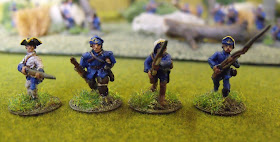 |
| Fort Avila |
The Battle of Fort Avila. 10th November 1808
Posties Rejects had a Napoleonic game last Saturday, I must admit, It was one of the best games I’ve ever played in and was a very close run thing, unfortunately we had to stop the game before the game had truly run its course, but we were all satisfied with the final result at the end. We started the game at 10am and finished at 430ishpm as I had to go to work!!
The sides
British - Surj, Spanish – Richard v Ray and Ian – French. The two French leaders were able to talk freely as their command bases were together, but the Allies were not allowed to talk and were only allowed to communicate by messengers.
Postie had set the game up and deployed all the troops, so there was no need for us to deploy, this saved a lot of time as all gamers will know. Postie gave both sides an order sheet, but also explained that things may happen during the game! Well what the hell’s that supposed to mean??? These “things”, caused mayhem and headaches for both sides throughout the game!!
 |
| The Battlefield |
The French Orders
You have been sent to capture Fort Avila and to control the surrounding area including the coastline. News arrives that a British fleet has been sighted of the northern coast. The French also have 10 ladders they can share out amongst the troops, to attack the fort.
The Spanish Orders
The French have arrived, hold out as long as you can, do not let the French capture the Fort at all costs. A peasant arrives with news that a British fleet is anchoring off the northern coast with British reinforcements onboard. The French must suffer for every inch of land they take as they advance toward you.
The British Orders
Spies have intercepted French messages stating that an attack will be made on the vital coastal Fortress of Avila. You are in command of a small army sent to help the Spanish and secure the safety of the fort and surrounding area from the forces of Bonaparte.
1st Division
1st Brigade - 1st,2nd and 3rd Battalions of 14th Line and 15th Legere,
2nd Brigade - 70th Line, Paris Municipal Guard 4th Swiss (elite) and 4th Legere (elite)2nd Division
1st Brigade - 1st, 2nd and 3rd Battalions of 2nd Vistula Legion, 27th Legere (elite)
2nd Brigade - 4 units of Combined Grenadiers (elite) (Not on the table at the start)
2 x Siege Artillery
1 x Med Artillery
1 company of Pioneers
Cavalry Division
1st Brigade – 23rd and 25th Dragoons (Not on the table at the start)
2nd Brigade - 1st Hussars and 10th Chasseurs a Cheval
The Spanish
1st Division
Garrison in fortress - 2 Militia Battalions, Avila and Tuy
Garrison in fortress - Betanzos Militia and 1st Aragon Light Infantry (Not on the table at the start)
Cavalry 2nd Brigade - 5th Borbon Horse and 5th Villavicosa Dragoons (Not on the table at the start)
2 x Heavy Artillery
1 x Light Artillery (Not on the table at the start)
The British
1st Division
1st Brigade - 1st and 2nd Battalion of Royal Marines and 1 Battalion of Sailors (all elite)2nd Brigade – 38th, 5th, 36th Line, 5/ 60th Rifles (elite)
1x light Artillery
 |
| The British army loading onto their boats |
 |
| Postie picked this ship up at a show a few years ago for just £30, a bargin if I've ever seen one! |
 |
| Nearly there |
Another unexpected action in the game then followed. The French could also throw an Average dice to see how many free fires it could take against the walls of the fort, before the game started, I threw a 3 and caused 9 hits, unfortunately we did not know the number it would take to cause a breach.
Turn 1
The French won the initiative and moved first. All the French Infantry advance toward the fortress, while the Cavalry marched off in column to try and block the bridges, to stop the British advance. The Brits moved toward both the bridges. The fortress took 1 more hit onto the Breach making 10 hits all together. The first casualty of the day was from the 10th Chasseur a Cheval, who were fired upon by Heavy gun No2 from the fort.
 |
| The French Infantry start their march to take the fort. |
 |
| The French 1st Hussars and 10th Chasseurs a Chaval |
 |
| The Elite British Marines and Sailors nearing the village of Nemo |
 |
| The 5/60th advancing through the woods |
The French won the first move again and kept up the mass advance, with the Cavalry still heading for the bridges. The British 1st Brigade moved passed the small village of Nemo, just in from the coast towards the bridge. 2 more hits were inflicted on the walls of the fort, now making 12. The Spanish heavy guns inflicted heavy casualties on the French 14th Line killing 4 figures and taking out the Brigade leader as well. Even after the devastation the 14th managed to pass their morale check. The other Spanish gun took 2 figures off of the 70th Line.
 |
| A view of the Battlefield at the start of turn 2 |
 |
| The French advance |
 |
| Here come the French |
 |
| The British 1st Division, 1st Brigade 1st & 2nd Marines and Sailors |
 |
| The French 10th Chasseurs a Chaval. |
Thanks for reading the post
Ray





































